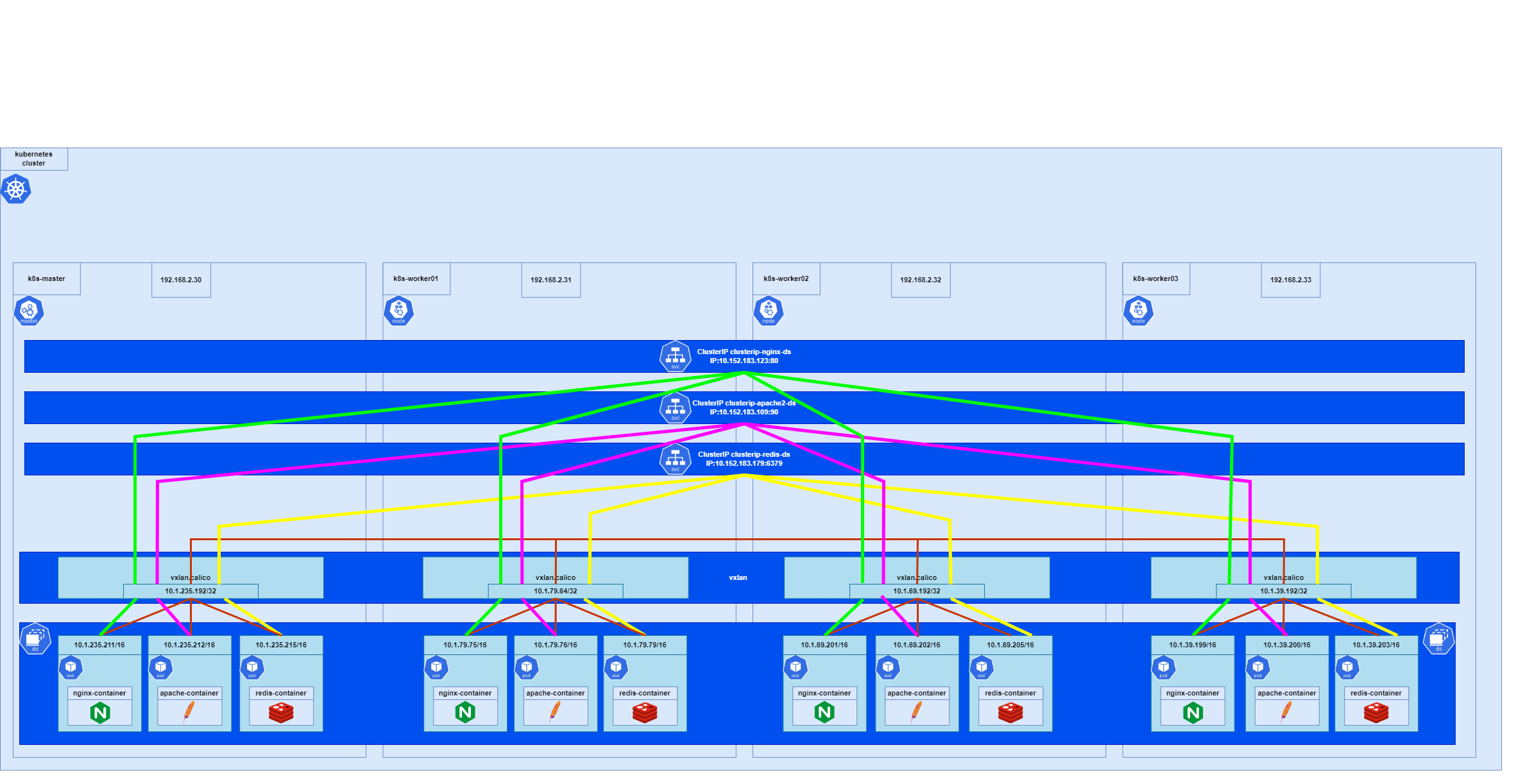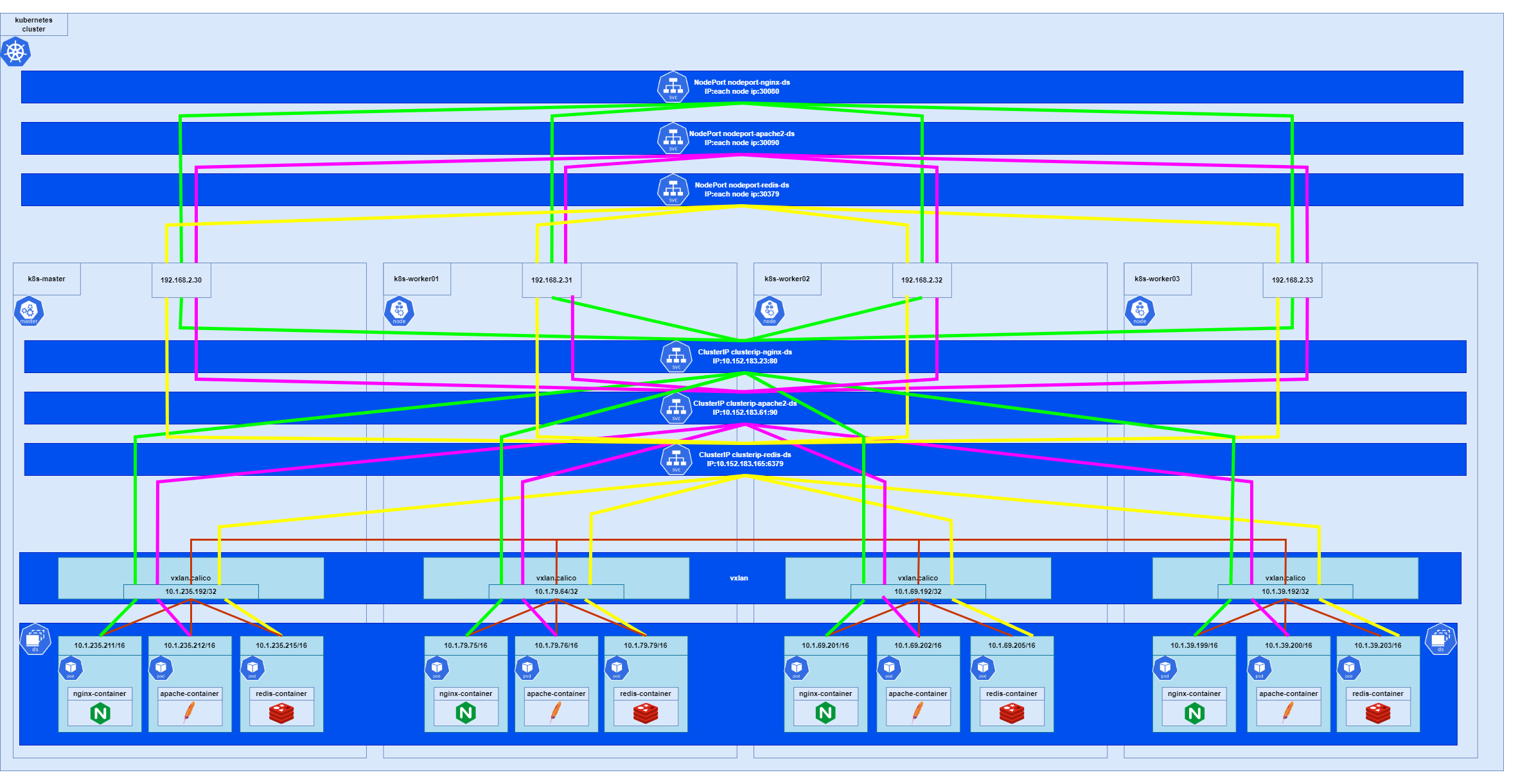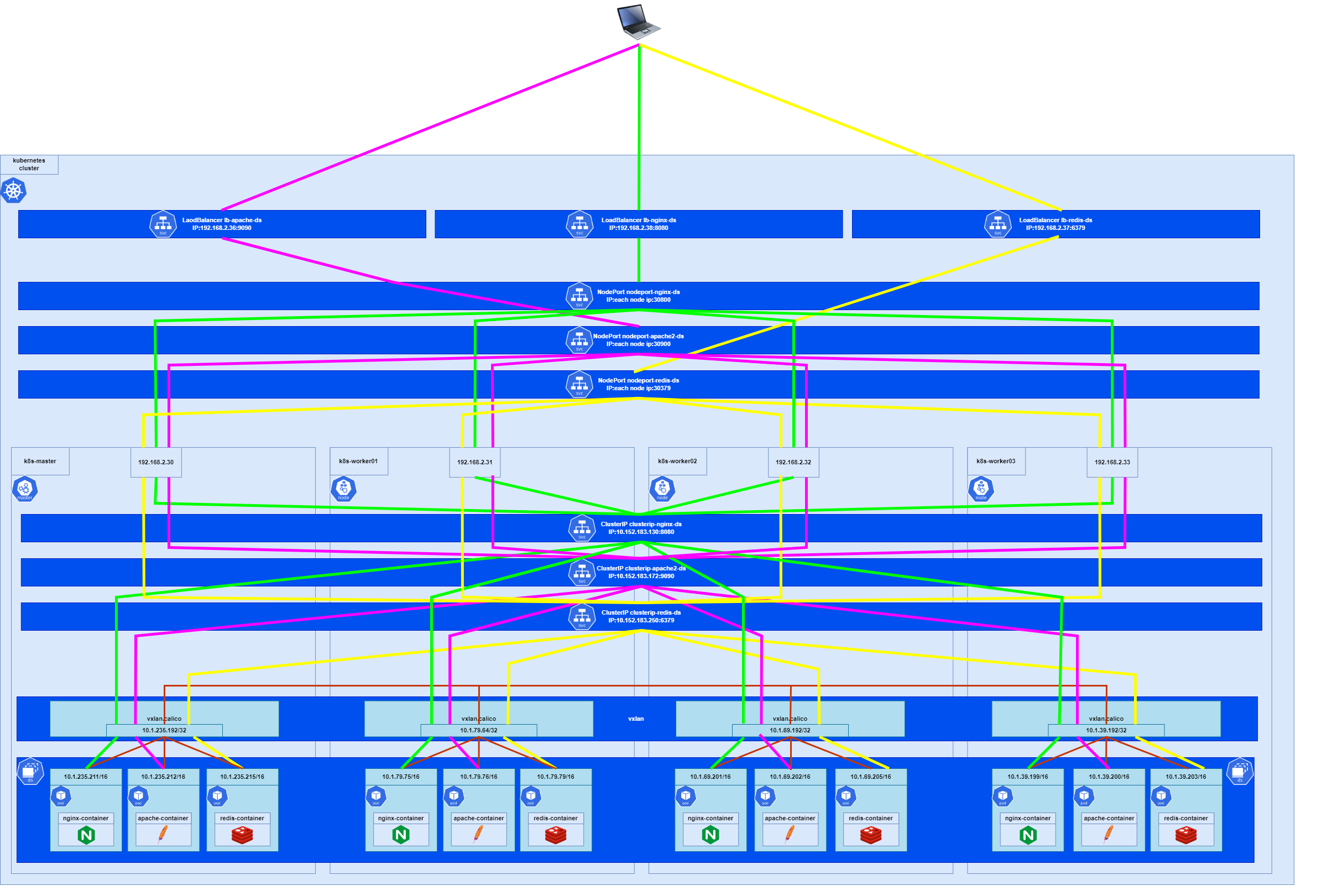こんにちは
株式会社クラスアクト インフラストラクチャ事業部の大塚です。
今回はタイトルにもあるようにk8sのネットワーク周りを不完全ながらも図に落とし込んでみて、自分の中でk8sのネットワーク周りの解像度をあげていければと思っています。『k8sのネットワークはおおよそタイトルにある4つが分かればイメージ出来るんじゃないかなぁ』と思う今日この頃。本当はVXLANの手前というか裏にLinuxBridgeみたいなのがいるんだろうなぁとは思いますが、確認しきれませんでした汗
※勉強途中の人間がそれっぽく図式化しているので精度はイマイチだと思われます。
※ClusterIPやNodePort,LoadBalancer辺りは図に落とし込まれているのを見るのですが、それより前のPod周りのネットワークを図に書いているのが印象になく、そのあたりを図に落とし込みたいなと思ったのが発端です。
環境
master nodeが1台、worker nodeが3台の計4台でk8sクラスタを構成しています。
nodeのOSはubuntu22.04。microk8sをインストールしているのですがmicrok8sのversionはv1.26.4になります。
root@k8s-master:~/yaml# kubectl get node -o wide
NAME STATUS ROLES AGE VERSION INTERNAL-IP EXTERNAL-IP OS-IMAGE KERNEL-VERSION CONTAINER-RUNTIME
k8s-worker01 Ready <none> 83m v1.26.4 192.168.2.31 <none> Ubuntu 22.04.2 LTS 5.15.0-71-generic containerd://1.6.15
k8s-master Ready <none> 91m v1.26.4 192.168.2.30 <none> Ubuntu 22.04.2 LTS 5.15.0-71-generic containerd://1.6.15
k8s-worker02 Ready <none> 73m v1.26.4 192.168.2.32 <none> Ubuntu 22.04.2 LTS 5.15.0-71-generic containerd://1.6.15
k8s-worker03 Ready <none> 83m v1.26.4 192.168.2.33 <none> Ubuntu 22.04.2 LTS 5.15.0-71-generic containerd://1.6.15
用語
ClusterIP
クラスター内部のIPでServiceを公開する。このタイプではServiceはクラスター内部からのみ疎通性があります。このタイプはデフォルトのServiceTypeです。
NodePort
各NodeのIPにて、静的なポート(NodePort)上でServiceを公開します。そのNodePort のServiceが転送する先のClusterIP Serviceが自動的に作成されます。"NodeIP:NodePort"にアクセスすることによってNodePort Serviceにアクセスできるようになります。
LoadBalancer
クラウドプロバイダーのロードバランサーを使用して、Serviceを外部に公開します。クラスター外部にあるロードバランサーが転送する先のNodePortとClusterIP Serviceは自動的に作成されます。
Calico
Calico は MicroK8 のデフォルトの CNI であり、VXLAN オーバーレイ ネットワークはポッド ネットワークの構成に使用されます。
Calico は、コンテナー、仮想マシン、およびネイティブ ホスト ベースのワークロード向けのオープン ソース ネットワーキングおよびネットワーク セキュリティ ソリューションです。Calico は、Kubernetes、OpenShift、Mirantis Kubernetes Engine (MKE)、OpenStack、ベアメタル サービスなど、幅広いプラットフォームをサポートしています。
IPAMやVXLAN環境をk8s(microk8s)に提供しているものみたいですね。
DeamonSet
DaemonSetは、すべての(または一部の)ノードがPodのコピーを実行することを保証します。ノードがクラスタに追加されると、Podが追加されます。ノードがクラスタから削除されると、これらのPodはガベージコレクションされます。DaemonSetを削除すると、それが作成したPodがクリーンアップされます。
DeamonSetをデプロイしてpod周りのネットワークを確認する
今回は3つのdsを用意しました。nginx用、apache2用、redis用になります。yamlファイルはそれぞれ以下となります。tolerationの設定は気にしないでください。
apiVersion: apps/v1
kind: DaemonSet
metadata:
name: nginx-ds
spec:
selector:
matchLabels:
name: nginx
template:
metadata:
labels:
name: nginx
spec:
tolerations:
- key: "env"
operator: "Equal"
value: "master"
effect: NoSchedule
containers:
- name: nginx-container
image: nginx:latest
apiVersion: apps/v1
kind: DaemonSet
metadata:
name: apache-ds
spec:
selector:
matchLabels:
name: apache
template:
metadata:
labels:
name: apache
spec:
tolerations:
- key: "env"
operator: "Equal"
value: "master"
effect: NoSchedule
containers:
- name: apache-container
image: shotaohtsuka/my-httpd-image
apiVersion: apps/v1
kind: DaemonSet
metadata:
name: redis-ds
spec:
selector:
matchLabels:
name: redis
template:
metadata:
labels:
name: redis
spec:
tolerations:
- key: "env"
operator: "Equal"
value: "master"
effect: NoSchedule
containers:
- name: redis-container
image: redis
これをデプロイしていきます。
IPアドレスが各node毎に概ね連番となっていることが分かります。連番になっていないところがあるのはデプロイに失敗して2,3回やり直したことによるものだと思われます。
root@k8s-master:~/yaml# kubectl get pod -o wide | grep -i k8s-master
nginx-ds-tkhgg 1/1 Running 0 23m 10.1.235.211 k8s-master <none> <none>
apache-ds-t6th6 1/1 Running 0 23m 10.1.235.212 k8s-master <none> <none>
redis-ds-zw869 1/1 Running 0 10m 10.1.235.215 k8s-master <none> <none>
root@k8s-master:~/yaml# kubectl get pod -o wide | grep -i k8s-worker01
nginx-ds-6nw9w 1/1 Running 0 23m 10.1.79.75 k8s-worker01 <none> <none>
apache-ds-xv25j 1/1 Running 0 23m 10.1.79.76 k8s-worker01 <none> <none>
redis-ds-bv2t9 1/1 Running 0 11m 10.1.79.79 k8s-worker01 <none> <none>
root@k8s-master:~/yaml# kubectl get pod -o wide | grep -i k8s-worker02
nginx-ds-k4ndq 1/1 Running 0 24m 10.1.69.201 k8s-worker02 <none> <none>
apache-ds-bmtwp 1/1 Running 0 24m 10.1.69.202 k8s-worker02 <none> <none>
redis-ds-d2ps6 1/1 Running 0 11m 10.1.69.205 k8s-worker02 <none> <none>
root@k8s-master:~/yaml# kubectl get pod -o wide | grep -i k8s-worker03
nginx-ds-gvx8m 1/1 Running 0 24m 10.1.39.199 k8s-worker03 <none> <none>
apache-ds-kzpns 1/1 Running 0 24m 10.1.39.200 k8s-worker03 <none> <none>
redis-ds-pfrpl 1/1 Running 0 11m 10.1.39.203 k8s-worker03 <none> <none>
k8sのpodに割り当てられるIPアドレスのレンジについては"/var/snap/microk8s/current/args/cni-network/cni.yaml"の以下の部分だと思われる。node毎に均等にレンジが割り当てられている様子。。。
# The default IPv4 pool to create on startup if none exists. Pod IPs will be
# chosen from this range. Changing this value after installation will have
# no effect. This should fall within `--cluster-cidr`.
- name: CALICO_IPV4POOL_CIDR
value: "10.1.0.0/16"
また、それぞれのnodeのvxlanのinterfaceを確認してみます。
root@k8s-master:~# ip a
11: vxlan.calico: <BROADCAST,MULTICAST,UP,LOWER_UP> mtu 1450 qdisc noqueue state UNKNOWN group default
link/ether 66:d5:cf:d3:6b:7e brd ff:ff:ff:ff:ff:ff
inet 10.1.235.192/32 scope global vxlan.calico
valid_lft forever preferred_lft forever
inet6 fe80::64d5:cfff:fed3:6b7e/64 scope link
valid_lft forever preferred_lft forever
root@k8s-worker01:~# ip a
5: vxlan.calico: <BROADCAST,MULTICAST,UP,LOWER_UP> mtu 1450 qdisc noqueue state UNKNOWN group default
link/ether 66:c1:17:77:92:d1 brd ff:ff:ff:ff:ff:ff
inet 10.1.79.64/32 scope global vxlan.calico
valid_lft forever preferred_lft forever
inet6 fe80::64c1:17ff:fe77:92d1/64 scope link
valid_lft forever preferred_lft forever
root@k8s-worker02:~# ip a
25: vxlan.calico: <BROADCAST,MULTICAST,UP,LOWER_UP> mtu 1450 qdisc noqueue state UNKNOWN group default
link/ether 66:ff:2b:bc:03:a3 brd ff:ff:ff:ff:ff:ff
inet 10.1.69.192/32 scope global vxlan.calico
valid_lft forever preferred_lft forever
inet6 fe80::64ff:2bff:febc:3a3/64 scope link
valid_lft forever preferred_lft forever
root@k8s-worker03:~# ip a
5: vxlan.calico: <BROADCAST,MULTICAST,UP,LOWER_UP> mtu 1450 qdisc noqueue state UNKNOWN group default
link/ether 66:fc:06:ba:9d:0e brd ff:ff:ff:ff:ff:ff
inet 10.1.39.192/32 scope global vxlan.calico
valid_lft forever preferred_lft forever
inet6 fe80::64fc:6ff:feba:9d0e/64 scope link
valid_lft forever preferred_lft forever
この辺りを図に落とし込むと以下の様になるかと思います。
赤い線がpod間通信に使われる経路になります。podにはvxlanのIPが振られてるのでnodeを跨いだ通信が既に出来るということですね。なんとなくClusterIPとかをデプロイして初めてnode間での通信が出来るのかと思ったのですがそうではないようです。

ClusterIPをデプロイする
用意したyamlファイルは以下となります。
portがClusterIPでListenするポート、targetPortがpodでListenするポートになりますね。
apiVersion: v1
kind: Service
metadata:
name: clusterip-nginx-ds
spec:
selector:
name: nginx
type: ClusterIP
ports:
- name: nginx
port: 80
protocol: TCP
targetPort: 80
apiVersion: v1
kind: Service
metadata:
name: clusterip-apache2-ds
spec:
selector:
name: apache
type: ClusterIP
ports:
- name: apache
port: 90
protocol: TCP
targetPort: 90
apiVersion: v1
kind: Service
metadata:
name: clusterip-redis-ds
spec:
selector:
name: redis
type: ClusterIP
ports:
- name: redis
port: 6379
protocol: TCP
targetPort: 6379
デプロイしていきます。
kubectl get svc -o wideのCLUSTER-IPに振られているIPアドレスがClusterIP serviceに実際に割り当てられているIPアドレスになります。
root@k8s-master:~/yaml# kubectl create -f clusterip-nginx-ds.yaml
service/clusterip-nginx-ds created
root@k8s-master:~/yaml# kubectl create -f clusterip-apache2-ds.yaml
service/clusterip-apache2-ds created
root@k8s-master:~/yaml# kubectl create -f clusterip-redis-ds.yaml
service/clusterip-redis-ds created
root@k8s-master:~/yaml# kubectl get svc -o wide
NAME TYPE CLUSTER-IP EXTERNAL-IP PORT(S) AGE SELECTOR
kubernetes ClusterIP 10.152.183.1 <none> 443/TCP 3d2h <none>
clusterip-nginx-ds ClusterIP 10.152.183.123 <none> 80/TCP 84m name=nginx
clusterip-apache2-ds ClusterIP 10.152.183.109 <none> 90/TCP 4m51s name=apache
clusterip-redis-ds ClusterIP 10.152.183.179 <none> 6379/TCP 8s name=redis
これを図に落とし込むと以下となります。
緑の線がnginx関連の通信経路、ピンクの線がapache関連の通信経路、黄色の線がredis関連の通信経路の認識です。

例えばnginxのClusterIPのIPアドレスにポートを紐づけてcurlをすることで以下の様に負荷分散しつつpodに接続をします。ただClusterIPはあくまで内部用のものになりますので、k8sクラスタ外から同様のことは出来ません。
root@k8s-master:~/yaml# curl 10.152.183.123:80
<!DOCTYPE html>
<html>
<head>
<title>Welcome to nginx!</title>
<style>
html { color-scheme: light dark; }
body { width: 35em; margin: 0 auto;
font-family: Tahoma, Verdana, Arial, sans-serif; }
</style>
</head>
<body>
<h1>Welcome to nginx!</h1>
<p>If you see this page, the nginx web server is successfully installed and
working. Further configuration is required.</p>
<p>For online documentation and support please refer to
<a href="http://nginx.org/">nginx.org</a>.<br/>
Commercial support is available at
<a href="http://nginx.com/">nginx.com</a>.</p>
<p><em>Thank you for using nginx.</em></p>
</body>
</html>
NodePortをデプロイする
用意したyamlファイルは以下となります。
portがClusterIPでListenするポート、targetPortがpodでListenするポート。nodePortがそれぞれのnodeでListenするポートとなります。NodePort Serviceをデプロイすると関連して内部でClusterIPもデプロイされるっぽいですね。
apiVersion: v1
kind: Service
metadata:
name: nodeport-nginx-ds
spec:
type: NodePort
selector:
name: nginx
ports:
- port: 80
targetPort: 80
nodePort: 30080
apiVersion: v1
kind: Service
metadata:
name: nodeport-apache2-ds
spec:
type: NodePort
selector:
name: apache
ports:
- port: 90
targetPort: 90
nodePort: 30090
apiVersion: v1
kind: Service
metadata:
name: nodeport-redis-ds
spec:
type: NodePort
selector:
name: redis
ports:
- port: 6379
targetPort: 6379
nodePort: 30379
デプロイしていきます。
kubectl get svc -o wideのCLUSTER-IPに振られているIPアドレスがClusterIP serviceに実際に割り当てられているIPアドレスになります。NodePort serviceデプロイ時に付与されているCLUSTER-IPとClusterIP serviceデプロイ時に付与されているCLUSTER-IPが違いますが、これがNodePortデプロイ時に関連するClusterIPもデプロイされることを示しているのかなと思います。
root@k8s-master:~/yaml# kubectl create -f nodeport-nginx-ds.yaml
service/nodeport-nginx-ds created
root@k8s-master:~/yaml# kubectl create -f nodeport-apache2-ds.yaml
service/nodeport-apache2-ds created
root@k8s-master:~/yaml# kubectl create -f nodeport-redis-ds.yaml
service/nodeport-redis-ds created
root@k8s-master:~/yaml# kubectl get svc -o wide
NAME TYPE CLUSTER-IP EXTERNAL-IP PORT(S) AGE SELECTOR
kubernetes ClusterIP 10.152.183.1 <none> 443/TCP 3d3h <none>
clusterip-nginx-ds ClusterIP 10.152.183.123 <none> 80/TCP 166m name=nginx
clusterip-apache2-ds ClusterIP 10.152.183.109 <none> 90/TCP 86m name=apache
clusterip-redis-ds ClusterIP 10.152.183.179 <none> 6379/TCP 81m name=redis
nodeport-nginx-ds NodePort 10.152.183.23 <none> 80:30080/TCP 17m name=nginx
nodeport-apache2-ds NodePort 10.152.183.61 <none> 90:30090/TCP 3m45s name=apache
nodeport-redis-ds NodePort 10.152.183.165 <none> 6379:30379/TCP 8s name=redis
図に落とすと以下となる認識です。
ここで少し気を付けないといけない点としてはClusterIPのIPは一個上で図式化した時のIPと違うということです。この図に落とし込めていませんが一個上で図式化したClusterIPもクラスタ上に存在しています。

LoadBalancerをデプロイする
lbをデプロイする前に検証環境のメモリが限界っぽかったので上記でデプロイしてきたsvcをdeleteします。
root@k8s-master:~/yaml# kubectl delete svc clusterip-nginx-ds clusterip-apache2-ds clusterip-redis-ds nodeport-nginx-ds nodeport-apache2-ds nodeport-redis-ds
service "clusterip-nginx-ds" deleted
service "clusterip-apache2-ds" deleted
service "clusterip-redis-ds" deleted
service "nodeport-nginx-ds" deleted
service "nodeport-apache2-ds" deleted
service "nodeport-redis-ds" deleted
root@k8s-master:~/yaml# kubectl get svc
NAME TYPE CLUSTER-IP EXTERNAL-IP PORT(S) AGE
kubernetes ClusterIP 10.152.183.1 <none> 443/TCP 3d4h
lbデプロイ用に用意したyamlファイルは以下です。
portがLoadBalancer及びClusterIPでListenするポート、targetPortがpodでListenするポート。nodePortがそれぞれのnodeでListenするポートとなります。LoadBalancer Serviceをデプロイすると関連して内部でNodePort,ClusterIPもデプロイされるっぽいですね。
apiVersion: v1
kind: Service
metadata:
name: lb-nginx-ds
spec:
type: LoadBalancer
selector:
name: nginx
ports:
- name: nginx
port: 8080
targetPort: 80
nodePort: 30800
apiVersion: v1
kind: Service
metadata:
name: lb-apache-ds
spec:
type: LoadBalancer
selector:
name: apache
ports:
- name: apache
port: 9090
targetPort: 90
nodePort: 30900
apiVersion: v1
kind: Service
metadata:
name: lb-redis-ds
spec:
type: LoadBalancer
selector:
name: redis
ports:
- name: redis
port: 6379
targetPort: 6379
nodePort: 30379
デプロイしていきます。
kubectl get svc -o wideのCLUSTER-IPに振られているIPアドレスがClusterIP serviceに実際に割り当てられているIPアドレスになります。NodePortのIPはそれぞれのnodeのIPになります。EXTERNAL-IPがLoadBalancerに振られるはずのIPになりますがpendingとなっています。これはMetalLBがdisableとなっている為です。このあと有効化します。
root@k8s-master:~/yaml# kubectl create -f lb-nginx-ds.yaml
service/lb-apache-ds created
root@k8s-master:~/yaml# kubectl create -f lb-apache2-ds.yaml
service/lb-apache-ds created
root@k8s-master:~/yaml# kubectl create -f lb-redis-ds.yaml
service/lb-redis-ds created
root@k8s-master:~/yaml# kubectl get svc -o wide
NAME TYPE CLUSTER-IP EXTERNAL-IP PORT(S) AGE SELECTOR
kubernetes ClusterIP 10.152.183.1 <none> 443/TCP 41m <none>
lb-nginx-ds LoadBalancer 10.152.183.130 <pending> 8080:30800/TCP 6m3s name=nginx
lb-apache-ds LoadBalancer 10.152.183.172 <pending> 9090:30900/TCP 88s name=apache
lb-redis-ds LoadBalancer 10.152.183.250 <pending> 6379:30379/TCP 7s name=redis
MetalLBを有効化します。
今回は192.168.2.36-40までをMetalLB用に確保しました。
root@k8s-master:~/yaml# microk8s enable metallb
Infer repository core for addon metallb
Enabling MetalLB
Enter each IP address range delimited by comma (e.g. '10.64.140.43-10.64.140.49,192.168.0.105-192.168.0.111'): 192.168.2.36-192.168.2.40
Applying Metallb manifest
customresourcedefinition.apiextensions.k8s.io/addresspools.metallb.io created
customresourcedefinition.apiextensions.k8s.io/bfdprofiles.metallb.io created
customresourcedefinition.apiextensions.k8s.io/bgpadvertisements.metallb.io created
customresourcedefinition.apiextensions.k8s.io/bgppeers.metallb.io created
customresourcedefinition.apiextensions.k8s.io/communities.metallb.io created
customresourcedefinition.apiextensions.k8s.io/ipaddresspools.metallb.io created
customresourcedefinition.apiextensions.k8s.io/l2advertisements.metallb.io created
namespace/metallb-system created
serviceaccount/controller created
serviceaccount/speaker created
clusterrole.rbac.authorization.k8s.io/metallb-system:controller created
clusterrole.rbac.authorization.k8s.io/metallb-system:speaker created
role.rbac.authorization.k8s.io/controller created
role.rbac.authorization.k8s.io/pod-lister created
clusterrolebinding.rbac.authorization.k8s.io/metallb-system:controller created
clusterrolebinding.rbac.authorization.k8s.io/metallb-system:speaker created
rolebinding.rbac.authorization.k8s.io/controller created
secret/webhook-server-cert created
service/webhook-service created
rolebinding.rbac.authorization.k8s.io/pod-lister created
daemonset.apps/speaker created
deployment.apps/controller created
validatingwebhookconfiguration.admissionregistration.k8s.io/validating-webhook-configuration created
Waiting for Metallb controller to be ready.
error: timed out waiting for the condition on deployments/controller
MetalLB controller is still not ready
deployment.apps/controller condition met
ipaddresspool.metallb.io/default-addresspool created
l2advertisement.metallb.io/default-advertise-all-pools created
MetalLB is enabled
MetalLB有効化後、再度kubectl get svc -o wideを実行するとpendingステートだったものが変わり、IPアドレスが振られていますね。
root@k8s-master:~/yaml# kubectl get svc -o wide
NAME TYPE CLUSTER-IP EXTERNAL-IP PORT(S) AGE SELECTOR
kubernetes ClusterIP 10.152.183.1 <none> 443/TCP 44m <none>
lb-apache-ds LoadBalancer 10.152.183.172 192.168.2.36 9090:30900/TCP 3m58s name=apache
lb-redis-ds LoadBalancer 10.152.183.250 192.168.2.37 6379:30379/TCP 2m37s name=redis
lb-nginx-ds LoadBalancer 10.152.183.130 192.168.2.38 8080:30800/TCP 8m33s name=nginx
この時の通信経路イメージです。
クラスタ上にはLoadBalancerしかなさそうに見えますが、実際はNodePort,ClusterIPがありPC→LB→NodePort→ClusterIP→podという順で通信をしているようです。
